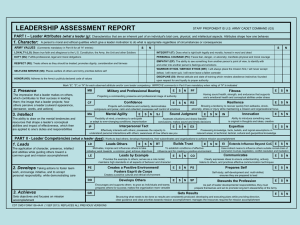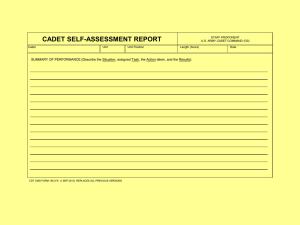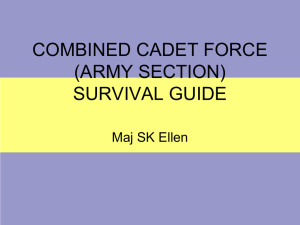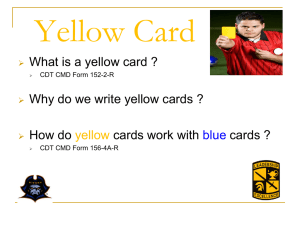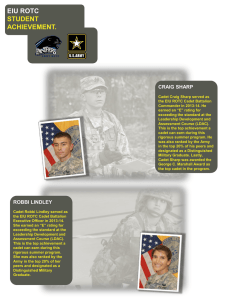Student Learning Assessment Program
advertisement
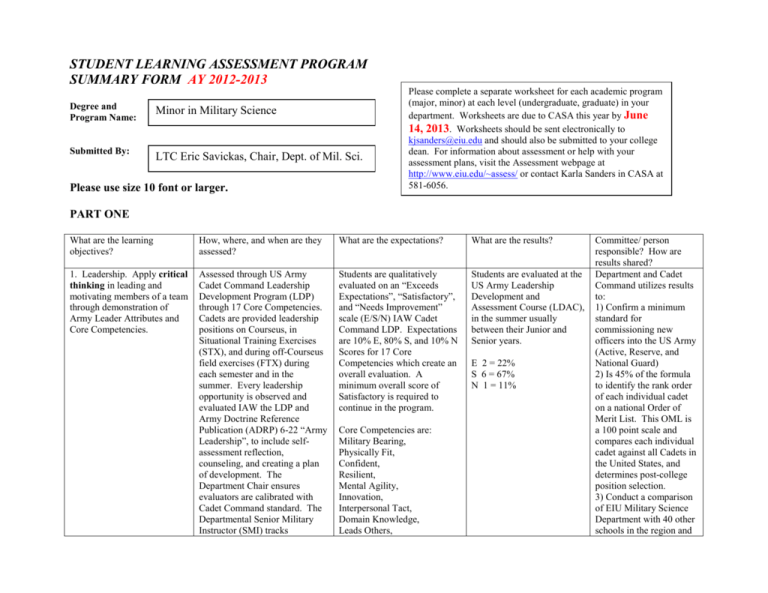
STUDENT LEARNING ASSESSMENT PROGRAM SUMMARY FORM AY 2012-2013 Degree and Program Name: Minor in Military Science Submitted By: LTC Eric Savickas, Chair, Dept. of Mil. Sci. Please use size 10 font or larger. Please complete a separate worksheet for each academic program (major, minor) at each level (undergraduate, graduate) in your department. Worksheets are due to CASA this year by June 14, 2013. Worksheets should be sent electronically to kjsanders@eiu.edu and should also be submitted to your college dean. For information about assessment or help with your assessment plans, visit the Assessment webpage at http://www.eiu.edu/~assess/ or contact Karla Sanders in CASA at 581-6056. PART ONE What are the learning objectives? How, where, and when are they assessed? What are the expectations? What are the results? 1. Leadership. Apply critical thinking in leading and motivating members of a team through demonstration of Army Leader Attributes and Core Competencies. Assessed through US Army Cadet Command Leadership Development Program (LDP) through 17 Core Competencies. Cadets are provided leadership positions on Courseus, in Situational Training Exercises (STX), and during off-Courseus field exercises (FTX) during each semester and in the summer. Every leadership opportunity is observed and evaluated IAW the LDP and Army Doctrine Reference Publication (ADRP) 6-22 “Army Leadership”, to include selfassessment reflection, counseling, and creating a plan of development. The Department Chair ensures evaluators are calibrated with Cadet Command standard. The Departmental Senior Military Instructor (SMI) tracks Students are qualitatively evaluated on an “Exceeds Expectations”, “Satisfactory”, and “Needs Improvement” scale (E/S/N) IAW Cadet Command LDP. Expectations are 10% E, 80% S, and 10% N Scores for 17 Core Competencies which create an overall evaluation. A minimum overall score of Satisfactory is required to continue in the program. Students are evaluated at the US Army Leadership Development and Assessment Course (LDAC), in the summer usually between their Junior and Senior years. Core Competencies are: Military Bearing, Physically Fit, Confident, Resilient, Mental Agility, Innovation, Interpersonal Tact, Domain Knowledge, Leads Others, E 2 = 22% S 6 = 67% N 1 = 11% Committee/ person responsible? How are results shared? Department and Cadet Command utilizes results to: 1) Confirm a minimum standard for commissioning new officers into the US Army (Active, Reserve, and National Guard) 2) Is 45% of the formula to identify the rank order of each individual cadet on a national Order of Merit List. This OML is a 100 point scale and compares each individual cadet against all Cadets in the United States, and determines post-college position selection. 3) Conduct a comparison of EIU Military Science Department with 40 other schools in the region and 2. Values and Ethics. Demonstrate a working knowledge of US and international military law and apply military ethics in decision making. 3. Personal Development. Demonstrate principles of time management, effective writing, and oral communication skills. evaluations through time for students and evaluators to identify weaknesses and strengths. Evaluators include all cadre and Senior ROTC Cadets who have graduated from Leadership Development and Assessment Course (LDAC) Extend Influence beyond CoC, Lead by Example, Communicates, Creates a Positive Environment, Prepares Self, Develops Others, and Gets Results. with all 273 Army ROTC programs in the nation. a. Assessed Values and Ethics through US Army Cadet Command Leadership Development Program (LDP) as Objective “1” through Leadership Attributes. a. Students are qualitatively evaluated on an Yes/No scale IAW Cadet Command LDP. Expectations and minimum score are 100% “YES” on the seven Army Values and Warrior Ethos. a. Students consolidated evaluations after LDAC. YES – 9 100% NO - 0 0% a. Cadre and US Army identify cadets who meet minimum value and ethical standard to be Army officers. All “NO” assessments are disenrolled from the program. b. Assessed military law through 1 Quiz and the MSC 4001 Final Exam: Military Law section which test the cadet on the Code of Conduct, Uniform Code of Military Justice, Rules of Engagement, and International Law of Warfare. Department Chair utilizes Cadet Command standardized testing. b. Students are quantitatively evaluated on a % Scale and expected to attain a 90% average in the Military Law Quiz and 90% in the Military Law section of the Final Exam. 60% is passing. b. Student numbers are from MSC 4001 Military Law sections. 90-better - 5 of 9 60-89% - 4 of 9 59% < - 0 of 9 b. Cadre analyze results, create remedial training as required and provide recommended curriculum changes to Cadet Command annually. a. Assessed through US Army Cadet Command Leadership Development Program (LDP) as Objective “1” through Communication and Get Results Core Competencies. a. Students are qualitatively evaluated on an E/S/N scale IAW Cadet Command LDP. Expectations are 10% E, 90% S, and 0% N Scores for 2 Core Competencies. a. Students individual Competency scores are after LDAC. a. As Objective 1. b. Assessed Written Communication through the US Army Writing Standard in accordance with (IAW) Army Regulation 25-50 and Field Manual 5-0 (Army Planning & Orders) during MSC 4001. b. Students are quantitatively evaluated on a % Scale and expected to attain a 90% average on a AR 25-50 memorandum writing assignment and 90% on an Operations Order (OPORD) b. Student numbers are from MSC 4001 Military Law sections. 90-better - 3 of 9 60-89% - 6 of 9 59% < - 0 of 9 Communication: E:2 S:7 N:0 Get Results: E:3 S:6 N:0 b. As Objective 2b. Department Chair makes final written assessment. writing assignment. 60% is passing. c. Assessed Oral Communication through the US Army Cadet Command oral presentation format in military science courses. Evaluation by course instructors by semester. c. Students are qualitatively evaluated by US Army Cadet Command directed oral evaluation sheet with a minimum ‘3’ Meets Expectations on a 5 point scale. Higher is better. 5- Superior Performance 4- Exceeded Standard 3- Meets Expectations 2- Marginal Performance 1- Failed to Achieve c. Student numbers are a composite for Fall and Spring. 5/ 4/ 3/ 2/ 1 MSC 1000: 3/ 10/ 12/ 7/ 2 MSC 2000: 2/ 4/ 8/ 1/ 0 MSC 3000: 3/ 6/ 2/ 1/ 0 MSC 4000: 2/ 6/ 1/ 0/ 0 c. As Objective 2b. 4. Officership. Demonstrate knowledge of the history and current applications of Profession of Arms and the Officer, to include the responsibilities of the Officer in the Army, the nation, and internationally as a global citizen. a. Assessed Profession of Arms through US Army Cadet Command Leadership Development Program (LDP) as Objective “1” through Military Bearing Core Competency. a. Students are qualitatively evaluated on an E/S/N scale IAW Cadet Command LDP. Expectations are 10% E, 90% S, and 0% N Scores a. Students individual Competency scores are after LDAC. a. As Objective “1” b. Assessed officer duty performance through designated battalion staff position during the senior year as part of MSC 4001, 4002 by the Department Chair by DA 67-9 IAW US Army Cadet Command requirements. b. Student numbers are from MSC 4001 Military Law sections. ACOM - 3 of 9 COM - 6 of 9 BCOM - 0 of 9 DNT – 0 of 9 b. Officer Evaluation Report provided to student, department, and Cadet Command for individual record of performance and potential. 5. Tactics and Techniques. Demonstrate knowledge and application of field craft skills and US Army troop leading procedures. Assessed Tactics and Techniques through US Army Cadet Command Leadership Development Program (LDP) as Objective “1” through Leads Others, Leads By Example, Extends Influence Beyond CoC. b. Students are qualitatively evaluated on an 4 Tier Scale IAW DA Form 67-9. Above Center of Mass, Center of Mass, Below CoM, and Do Not Retain. Minimum expectation is Center of Mass. Students are qualitatively evaluated on an E/S/N scale IAW Cadet Command LDP. Expectations are 10% E, 90% S, and 0% N Scores for 3 Core Competencies. Students individual Competency scores are after LDAC. As Objective “1” Mil Bearing: E:2 S:7 N:0 Leads Others: E:2 S:7 N:0 Lead by Example: E:3 S:6 N:0 Extend the Influence: E:1 S:8 N:0 PART TWO Describe your program’s assessment accomplishments since your last report was submitted. Discuss ways in which you have responded to the CASA Director’s comments on last year’s report or simply describe what assessment work was initiated, continued, or completed. The response in 2011 did not note any deficiencies which needed to be corrected to ensure quality in the program. The Department of Military Science uses the metrics described above as the primary means of assessing the program. In addition, United States Army Cadet Command and the department use After-Action Reviews and survey instruments to assist in determining any adjustments required. PART THREE Summarize changes and improvements in curriculum, instruction, and learning that have resulted from the implementation of your assessment program. How have you used the data? What have you learned? In light of what you have learned through your assessment efforts this year and in past years, what are your plans for the future? United States Army Cadet Command revises the curriculum for all MSC courses each year. Recent revisions have included a larger focus on critical thinking and adaptability. Additionally, US Army Cadet Command has recently incorporated aspects of the Experiential Learning Model in the way classes are prepared and presented. This allows for more participative learning rather than the previous “Death by PowerPoint” which was common in military science classes. Objective results have demonstrated through qualitative increase of cadets on the Cadet Command Order of Merit List.
